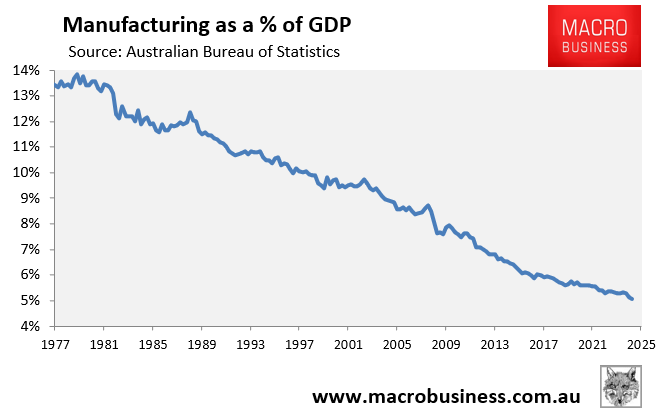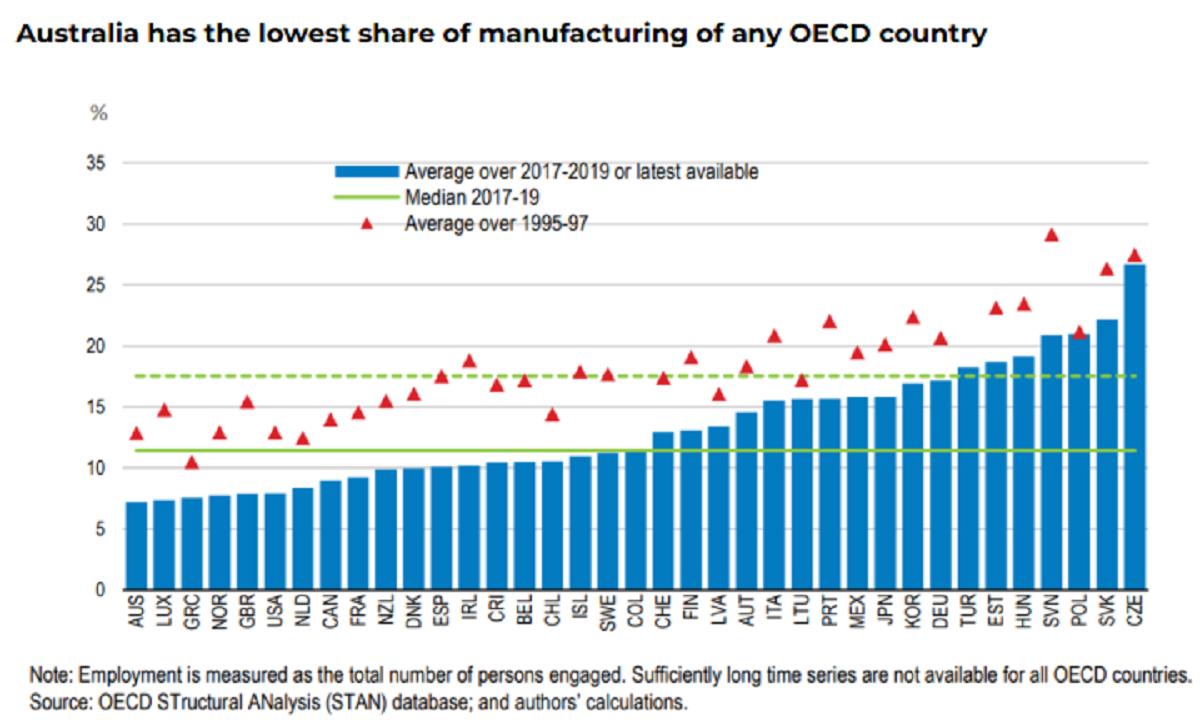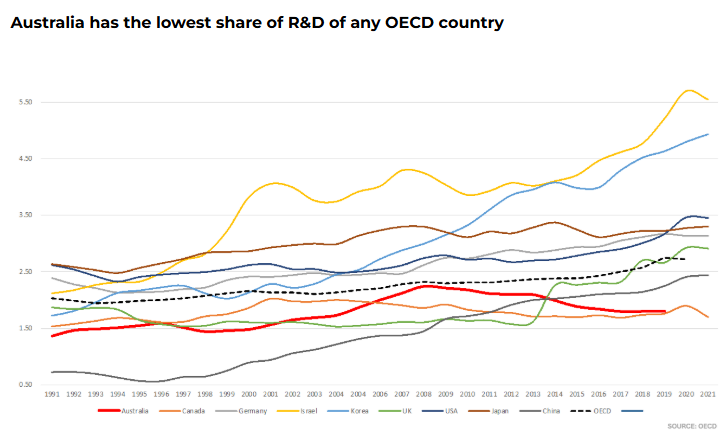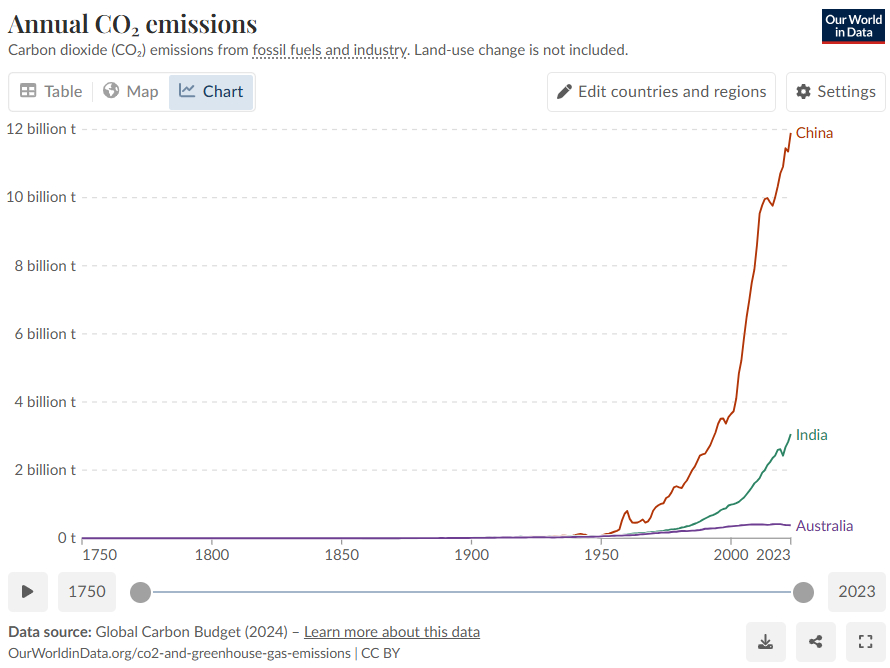Australia’s manufacturing sector hit a record low share of GDP in the latest Australian Bureau of Statistics (ABS) national accounts.
In Q1 2025, the manufacturing share of GDP fell to just 5.1%, down from 8.9% two decades ago and from 15% in the mid-1970s.

Australia’s manufacturing share is also the smallest in the OECD, making us one of the least self-sufficient economies in the developed world.

According to the 2024 Harvard Atlas of Economic Complexity, Australia ranked 102nd out of 145 countries, trailing Bangladesh (100) and Senegal (101) in terms of export diversification and knowledge intensity.
Australia’s annual R&D spending has also fallen to only 1.68% of GDP, well below the OECD average (3%) and the lowest among developed nations.

Australia is the world’s largest exporter of coal and the second-largest exporter of natural gas. It exports around five times more coal than it consumes and around four times more gas.
Australia also has the world’s largest endowment of uranium.
Australia, therefore, should have some of the world’s cheapest gas and electricity prices but has instead chosen to deny itself access to this energy while it exports energy security to Asia, including China and India.

The reality is that Australia’s manufacturing sector will continue to shrink so long as energy prices—gas and electricity—continue to rise in the futile pursuit of ‘net zero’.
Respected former ABC journalist, Chris Uhlmann, spelled out the reality in his recent podcast with John Anderson.
Edited Transcript:
It is the most massive exercise in virtue signaling which will essentially do absolutely nothing for the planet particularly out of a country like Australia which is just over 1% of the world’s emissions.
So what we are doing now is engaging in extremely expensive exercise because people see the imperative that we have to do something about climate change. But unfortunately, the problem for Australia is that it won’t do anything about that, and a large part of the rest of the world is not doing anything about trying to address its emissions at all.
So we essentially are retooling our grid around a system that won’t function, which will be highly expensive and will deliver us into poverty essentially if we stay on this pathway.
We will not be able to manufacture anything in Australia. Because the other things that we’re going to need with manufacturing is industrial heat. You are not going to get that out of wind or solar either. What we’re going to see in the end, and we’re seeing it already, is the shuttering of our industry around Australia as this kind of energy is rolled out because it’s inadequate for the purpose.
We’re going from a system that delivered us stable, affordable power in the 20th century to a system that’s going to deliver us unstable, unaffordable power in the 21st.
Think about this, John. Australia came to a settlement at the beginning of the 20th century, which was that we would be a high-wage economy but we were a low-energy-cost economy. So that equation worked for us in the 21st century.
We cannot be both a high-wage and a high-energy-cost economy because no one is going to pay the bill for our lifestyle…
What people need to do is to tell them the truth that if we continue on this path, it’s going to be very expensive. You will see the price in your electricity bill. And that will just be the beginning of it because you’ll also see the price in your food bill because high electricity prices will drive the cost of everything up. You’ll also see it in our manufacturing as the high costs of energy drives those sorts of things out of businesses as jobs disappear.
Wherever you want to look, Australia will pay a disproportionately high price for this…
If we’re going to make this transition, then the one thing that we could demand of all of our elite leaders is simply this: tell the truth. What is the cost going to be?
But we saw this through the last election with Chris Bowen our energy minister where he had promised a $275 reduction in bills by now. Instead, the Australian taxpayer is forking out $6.8 billion to try and dull the pain that’s coming from their electricity bills.
So there’s this giant Ponzi scheme where we’re taking money from taxpayers and then recycling it back into the bills of consumers and calling that cost of living relief.
The full hour-long interview is excellent and well worth watching.
The reality is that cheap and reliable energy is the bedrock of a modern economy.
Without cheap and reliable energy, Australia will become even more of an industrial wasteland, with a less diversified and complex economy, lower productivity, a higher cost of living, and ultimately lower living standards.

